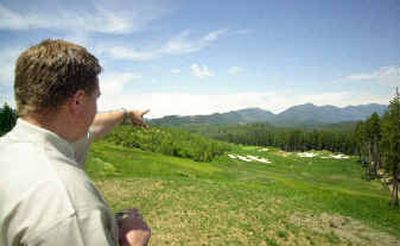Golf developers play risk-reward

ROSLYN, Wash. — Towering pine trees, empty mine shafts and rising slag piles serve as reminders of this town’s history, while finely trimmed fairways and greens embody a dream of its future.
A mere 90 minutes east of Seattle and little more than a driver off Interstate 90, developer Lowe Enterprises and manufacturer Jeld-Wen are banking that this sleepy foothill town can become a glossy golfer’s resort destination.
“When you go into a project like this, there is a lot of risk involved,” said Bill Hunt, the onsite Managing Director of Suncadia Resort. “But it’s a risk well worth taking.”
In a dream that echoes in small towns around the rural West, developers hope to reap a share of the affluent Seattle vacationers who now travel to golf-oriented resorts in Oregon, California or British Columbia.
The resort opened to the public earlier this month with the first nine holes of a planned 54-hole golf complex. All 18 holes of the first course, Prospector, designed by the Arnold Palmer Development Co., are scheduled to open around Labor Day.
It’s stage one in a multi-development plan that could include more than 3,000 residences, a hotel, village, conference center and numerous other recreational activities.
Developers are investing $80 million into the project just this summer alone and by 2014, Suncadia officials expect the property to be worth $1 billion in real estate alone.
The model for this dream is nearly 300 miles south: Sunriver, Ore., a hugely popular resort community with world-class golf courses, fancy boutiques and high-end restaurants.
“This place has the land and the landscape to be the next Sunriver,” said assistant golf pro Jeff Gay. “But on our scale.”
The resort sits on a massive 6,000-acre plot as the eastern slopes of the Cascade Mountains begin their decent into the high desert of the Columbia Basin.
Yet, Roslyn and its neighbor 5 miles south, Cle Elum, would hardly be considered resort fodder. Roslyn’s claim to fame is its stand-in role as the fictional town of Cicely, Alaska, in the television show “Northern Exposure.”
The two towns’ combined population was less than 3,000 according to the 2000 census.
Streets are lined with gas stations and small family restaurants that serve mostly as pit stops for passing travelers. Most shopping aside from groceries requires a trip over the mountains to the Seattle area or 30 miles southeast to Ellensburg.
Sunriver, meanwhile, is filled with stores, restaurants and recreational activities aimed at the non-golfers in the family. In winter, it’s a popular base for downhill and cross-country skiers.
Suncadia will try to capitalize on winter as well, with cross country skiing on the property and downhill at Snoqualmie Pass 30 minutes away.
Upping the ante for the developers is the glut of golf courses in the country. More courses were built during the 1990s than any other time except the 1960s, according to Pellucid, an independent golf research company.
That was good news for players, who get more golf for less money, but it’s put some developers out of business.
“In this region, we have an overabundance of golf courses; to the players’ benefit but the operators’ detriment,” Pacific Northwest Golf Association executive director John Bodenhamer said. “Most times, it’s the second or third owner that ends up making a profit.”
The National Golf Foundation figures that roughly 90 golf courses in the United States have closed in the past two years, roughly double the average rate in recent years.
Even in such a bleak climate, success stories feed their dream. Courses like Pinon Hills in Farmington, N.M. and Karsten Creek in Stillwater, Okla. are consistently considered among the top echelon of public courses in the nation, despite their remote locations.
Savvy state tourism officials are promoting “golf trails” — multi-day expeditions to multiple courses — in the unlikely locales of Alabama, Maine, Mississippi, Louisiana and Tennessee. Idaho recently announced its own golf trail.
The ultimate success might be Bandon, Ore., where Bandon Dunes and Pacific Dunes turned a small hamlet along the southern Oregon coast into a golfing destination on par with the revered Monterey Peninsula in California.
One form of insurance against the gamble is a big-name course designer. That’s why Suncadia chose Palmer’s company for Prospector and Tom Doak, the designer of Pacific Dunes, for the next 18 to be built.
“You search out for names that are attractive,” Hunt said. “That’s not to say some of the lesser known designers are not good, but the Palmer name is recognized more. And Doak has become a hot name.”
Prospector is designed to flow with the natural terrain, with mounding and swales that mimic the surrounding mountains and valleys, said John Thronson, the on-site course designer.
Thronson said Prospector and Suncadia as a whole will stand out in Northwest golf, in part because of the massive scale of the place.
“What’s unusual is the size of it. It’s difficult to zone something like this in the Northwest, and I don’t see something like this in the Northwest in the next 20 years,” Thronson said.